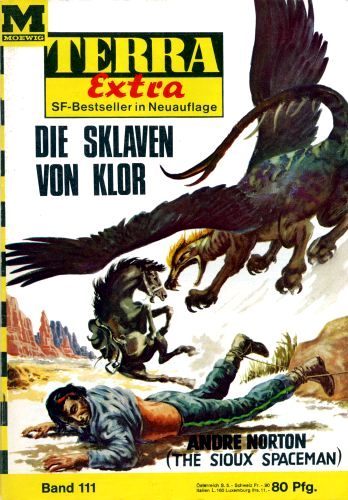Slice of PIE: THE SIOUX SPACEMAN (Beware the Horseman of the Stars) (1960) by Andre Norton –Part Two of a Review
 NOT using the panel discussions of the most recent World Science Fiction Convention in San Jose, CA in August 2018 (to which I be unable to go (until I retire from education)), I would jump off, jump on, rail against, and shamelessly agree with the BRIEF DESCRIPTION given in the pdf copy of the Program Guide. But not today. This explanation is reserved for when I dash “off topic”, sometimes reviewing movies, sometimes reviewing books, and other times taking up the spirit of a blog an old friend of mine used to keep called THE RANTING ROOM…
NOT using the panel discussions of the most recent World Science Fiction Convention in San Jose, CA in August 2018 (to which I be unable to go (until I retire from education)), I would jump off, jump on, rail against, and shamelessly agree with the BRIEF DESCRIPTION given in the pdf copy of the Program Guide. But not today. This explanation is reserved for when I dash “off topic”, sometimes reviewing movies, sometimes reviewing books, and other times taking up the spirit of a blog an old friend of mine used to keep called THE RANTING ROOM…Part 1 is here: https://faithandsciencefiction.blogspot.com/2018/12/slice-of-pie-sioux-spaceman-beware.html
Andre (Alice Mary) Norton’s THE SIOUX SPACEMAN is an adolescent space adventure story – duh. It’s what she wrote, from her first novel, THE PRINCE COMMANDS (“a straight-up adventure novel” – Lin Carter [an American author of science fiction and fantasy, as well as an editor, poet and critic…influential as a critic of contemporary fantasy and a pioneering historian of the genre…an editor for Ballantine Books…he sponsored the Gandalf Award…” Wikipedia], from the profile of Norton in the first edition of THE SIOUX SPACEMAN.
She did have some Native American heritage: “A common theme in the books is the presence of sympathetically presented feudal and tribal cultures. In several books Native American tribes and their various analogues are given a chance to be more successful than they were in actual American history. (Norton often told friends that she was proud of her little bit of Native American ancestry.) Nonhuman creatures and cultures are usually presented sympathetically, with human protagonists sometimes supporting them against oppressive human authorities. In contrast, several books present technological and mechanized cultures as negative or even positively evil.”
So – what do I think? I think she was daring. In an era when “America” was everything – it was the BEGINNING of the civil rights movement – she dared to posit a world where white Americans had killed each other off: “Norton doesn't give many specifics, but we learn that on Earth, the white Western civilization bombed itself into extinction. When civilization rebuilt itself, the Federation of Tribes emerged as a leader in a world dominated by Native Americans, Africans, Latinos, and the Chinese.”
As a former teacher and now a counselor in a diverse near-urban high school, these are the kids I see most often (though, instead of Chinese, we have a large population of Hmong – again, people driven from their original lands by the Han migration of Chinese settlers during the Qing Dynasty in the late 19th Century). We also have a large number of Liberian, Somalian, and Ethiopian students as well as students from Mexico, Ecuador, and Guatemala. This future isn’t very hard for me to imagine. Also, though we don’t have many students from South Korea, I was there for three weeks this summer and I can see a future where South Korea is a far larger player than most people would think (how about this: Kia, Hyundai, Samsung, and SK Electronics…as a point of reference, my spell checker didn’t indicate that any of those are misspelled).Kade Whitehawk is far out of the stereotype (though the cover of the books – except for the German edition I have above – do absolutely nothing to break the “injun” bias of the time, go so far as giving Kade the winged-hawk-beaked-jingle-bell-helmet/thingy on the cover of the first edition) that prevails in the US today.At the time the SPACEMAN was written, it was far, far out of the expectations and images of Native Americans – even today in the second decade of the 21stCentury. (http://time.com/3916680/native-american-hollywood-film/) Native Americans STILL have to stand in the shadows as white Americans play the parts of THEM – “…Hollywood mainstream has cranked out a fledging resurgence of Westerns with (mostly panned) movies such as Cowboys & Aliens (2011) and The Lone Ranger (2013). In these projects, Native American actors have been restricted to background roles…”As I said before, I think some company – preferably a publishing owned by Native Americans – buy the rights to SPACEMAN and then continue the series, developing both Kade and the Confederation on Earth. I think it would be fascinating…But given the current political climate, Native Americans have virtually no visibility in politics – starting with the 2019 Congress, there will be “…four Native Americans. When their terms begin, Davids and Haaland will become the first two Native American women with documented tribal ancestry to serve in Congress.”From the first in 1817, to the present, twenty-two Native Americans have served as senators or representatives. [For those interested in such things: R=8; D=12; R/D = 2] (https://en.wikipedia.org/wiki/List_of_Native_Americans_in_the_United_States_Congress)We have a long, long way to go before we reach a place where Native Americans (in particular) play a natural role in fiction, but I believe Andre (Alice) Norton made a solid start.For another interesting discussion of indigenous science fiction, read this: http://aidanmoher.com/blog/featured-article/2014/04/ghosts-representation-indigenous-peoples-north-america-science-fiction-fantasy-maureen-kincaid-speller/
Sources: http://andre-norton-books.com/index.php/worlds-of-andre/individual-novels-by-andre/243-sioux-spaceman-the, https://en.wikipedia.org/wiki/Andre_Norton, https://strangerthansf.com/reviews/norton-siouxspaceman.htmlImage: http://www.isfdb.org/wiki/images/3/3c/DSKLVNVKLR1966.jpg
Published on December 09, 2018 12:15
No comments have been added yet.



